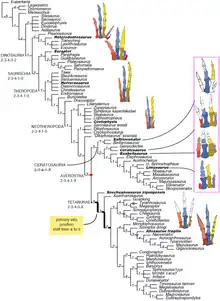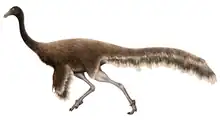Berberosaurus
Berberosaurus (meaning "Berber lizard", in reference to the Berbers of Morocco) is a genus of neotheropod dinosaur, possibly a ceratosaur, from the Toarcian-age (Lower Jurassic) "Toundoute Continental Series" (Azilal Formation) found in the Central High Atlas of Toundoute, Ouarzazate, Morocco. The type species of the genus Berberosaurus is B. liassicus, in reference to the Lias epoch. Berberosaurus might be the oldest known ceratosaur, and is based on partial postcranial remains. This genus represents the oldest formally identified theropod from the North of Africa, as well one of the few from the region in the Early Jurassic.[2]
| Berberosaurus Temporal range: Toarcian, Uncertain allocation of the layers | |
|---|---|
 | |
| Life restoration and size comparison | |
| Scientific classification | |
| Domain: | Eukaryota |
| Kingdom: | Animalia |
| Phylum: | Chordata |
| Clade: | Dinosauria |
| Clade: | Saurischia |
| Clade: | Theropoda |
| Clade: | Averostra |
| Clade: | †Ceratosauria |
| Genus: | †Berberosaurus |
| Species: | †B. liassicus |
| Binomial name | |
| †Berberosaurus liassicus Allain et al., 2007 | |
| Synonyms | |
| |
Discovery and history
The remains of Berberosaurus were discovered during a series of expeditions to the High Atlas beginning in the early 2000s, when in 6 years, several expeditions where made to dig in the local redbeds. It is based on an associated partial postcranial skeleton of a subadult individual cataloged in the Muséum d'Histoire Naturelle de Marrakech; bones from this skeleton include MHNM-Pt9 a neck vertebra;MHNM-Pt23, an anterior part of the sacrum; MHNM-Pt22, a metacarpal; MHNM-Pt19, a femur; MHNM-Pt21, proximal end of the left tibia; MHNM-Pt20, both fibulae; MHNM-Pt16, part of another femur, has been assigned to the genus as well. Its remains were found alongside those of Tazoudasaurus and an indeterminate large-bodied theropod within bone beds in mudflow deposits. Later tectonic activity has affected the bones.[2] Recent papers have quoted that new material of this genus was recovered on the same area, namely the axis, a postorbital, the cranium and teeth, that are currently being studied.[3] Berberosaurus is characterized by the following features: the cervical vertebra is highly pneumatic, with short cervical centra and holes in the neural arch, with low and short neural spine, unlike Elaphrosaurus and Ceratosaurus. It has anteroposteriorly short centra and neural spine; the sacral series markedly arched; the central sacrum narrow transversely; the metacarpal with a very grooved proximal end; anterior femoral trochanter reaches proximally to the midpoint of the femoral head, unlike Ceratosaurus; large femoral trochanteric platform; tibia with subtriangular distal profile; presence of an oblique ridge that covers proximally the medial sulcus of the fibula.[2]
Classification
Ronan Allain and colleagues, who described Berberosaurus, performed a phylogenetic analysis and found their new genus to be the most basal known abelisauroid, more derived than Elaphrosaurus, Ceratosaurus, and Spinostropheus, but less so than Xenotarsosaurus and abelisaurians. Berberosaurus is distinguished from other theropods by anatomical details found in its vertebrae, metacarpals, and hindlimb bones. Its assignment as an abelisauroid pushes back the record of this group and shows that it had diversified by the Early Jurassic.[2] However, Carrano and Sampson (2008) found it to be a basal ceratosaur outside Neoceratosauria instead.[4] Subsequently, the analysis of Xu et al. (2009) recovered it as a dilophosaurid in unresolved polytomy with Dilophosaurus wetherilli, "Dilophosaurus" sinensis, Dracovenator and Cryolophosaurus.[5] The phylogenetic analysis performed by Ezcurra, Agnolin and Novas (2010) recovered Berberosaurus in unresolved polytomy with Ceratosaurus and Abelisauroidea,[6] while the 2018 description of the basal ceratosaur Saltriovenator places Berberosaurus as the sister taxon to that genus.[7] Same year, a paper found Berberosaurus in different positions: considered as a basal ceratosaurian, a neoceratosaurian or a basal abelisauroid.[8] The paper which described Berberosaurus was the last one to find a monophyletic Ceratosauria that contained both Coelophysoids and Neoceratosaurs, most papers have since excluded Coelophysoidea from Ceratosauria and instead have favored the idea that Tetanurae and Ceratosauria are both part of a monophyletic group called Averostra, a classification which was already gaining popularity at around that time.[9]
The classification of Berberosaurus based on Delcourt et al. (2018):
| Ceratosauroidea |
| ||||||||||||||||||||||||||||||||||||||||||||||||||||||||||||||||||||||||||||||||||||||||||||||||||||||||||||||||||||||||||||||||||||||||||||||||
Paleoecology and paleobiology
Berberosaurus, like other ceratosaurians, was a bipedal carnivore.[10] It was of moderate size; its estimated femur length of 50.5 centimetres (19.9 inches)[2] is comparable to femur lengths given by Gregory S. Paul for animals like Elaphrosaurus (52.9 cm (20.8 in))[11] and Dilophosaurus (55.0 cm (21.7 in)).[12] Its remains were found with those of the early sauropod Tazoudasaurus. It has been estimated to be approximately 5 m (16 ft) long and 220–300 kg (490–660 lb) in body mass.[13][14]
The "Toundoute Continental Series", unlike other members of the Azilal Formation, due to the presence of volcanic material of coeval age. The Azilal Formation recovers a Terrestrial progradation that happened in the Central High Atlas Basin towards the Toarcian, where the older Pliensbachian Carbonate Platform retreated to the east. The lithology of this unit at Tundoute is divided in 5 units from D to H, (A-C represent the units of the underlying marine dolomite, C representing a transition to a terrestrial environment).[15] This layers have been referred to a Pliensbachian-Toarcian age, based on outdated data, as the underliying Carbonates where quoted to be a continuation with less thickess of the ones found in Todhra, that reach the Late Pliensbachian, being eveidence of a latter progradation than the one seen in the N, for example at Béni-Mellal.[16] The section including the bones of Berberosaurus was likely deposited on a channel/floodplain type fluvial system, with sand-filled channels abundant in plant roots (mostly located in fine limestone, probably from the channel margins), developed in the near E-W direction of transit. This layers also recover the presence of thick (up to 6 m) gypsium facies, what suggest the presence of a local Chott, indicating a succession of humid and dry seasons.[15] Based on mesofossils, local vegetation was apparently dominated by ferns, cycads and conifers.[15] Apart from Berberosaurus, Tazoudasaurus and a large-bodied theropod of uncertain affinities, a possible Coelophysidae with juvenile & adult specimens and a small sauropod have been recovered from Acforcid, E of Demnate, as well Gravisaurian (Tazoudasaurus?[17]) remains at the E of Azilal village, Medium-Sized Sauropod remains at Mizaguène Hill (SW Azilal) and indeterminate Dinosaur remains from other locations around Azilal and Demnate.[18]
See also
References
- Torices, A. (2013). "Theropod dinosaurs from the Upper Cretaceous of the South Pyrenees Basin of Spain". Acta Palaeontologica Polonica. doi:10.4202/app.2012.0121.
- Allain, Ronan; Tykoski, Ronald; Aquesbi, Najat; Jalil, Nour-Eddine; Monbaron, Michel; Russell, Dale; Taquet, Philippe (2007). "A basal abelisauroid from the late Early Jurassic of the High Atlas Mountains, Morocco, and the radiation of ceratosaurs" (PDF). Journal of Vertebrate Paleontology. 27 (3): 610–624. doi:10.1671/0272-4634(2007)27[610:AADTFT]2.0.CO;2. S2CID 131617581.
- Ibrahim, N.; Sereno, P. C.; Zouhri, S.; Zouhri, S. (2017). "Les dinosaures du Maroc–aperçu historique et travaux récents". Mémoires de la Societé géologique de France. 180 (4): 249–284. Retrieved 21 April 2023.
- Carrano & Sampson, 2008. The phylogeny of Ceratosauria (Dinosauria: Theropoda). Journal of Systematic Palaeontology. 6, 183-236.
- Xu, X.; Clark, J.M.; Mo, J.; Choiniere, J.; Forster, C.A.; Erickson, G.M.; Hone, D.W.E.; Sullivan, C.; Eberth, D.A.; Nesbitt, S.; Zhao, Q.; Hernandez, R.; Jia, C.-K.; Han, F.-L. & Guo, Y. (2009). "A Jurassic ceratosaur from China helps clarify avian digital homologies (supplementary information)" (PDF). Nature. 459 (7249): 940–944. doi:10.1038/nature08124. PMID 19536256. S2CID 4358448.
- Ezcurra, M.D.; Agnolin, F.L.; Novas, F.E. (2010). "An abelisauroid dinosaur with a non-atrophied manus from the Late Cretaceous Pari Aike Formation of southern Patagonia" (PDF). Zootaxa. 2450: 1–25. doi:10.11646/zootaxa.2450.1.1.
- Dal Sasso, Cristiano; Maganuco, Simone; Cau, Andrea (2018). "The oldest ceratosaurian (Dinosauria: Theropoda), from the Lower Jurassic of Italy, sheds light on the evolution of the three-fingered hand of birds". PeerJ. 6: e5976. doi:10.7717/peerj.5976. PMC 6304160. PMID 30588396. S2CID 56894865.
- Delcourt, R. (2018). "Ceratosaur palaeobiology: new insights on evolution and ecology of the southern rulers". Scientific Reports. 8 (1): 9730. Bibcode:2018NatSR...8.9730D. doi:10.1038/s41598-018-28154-x. PMC 6021374. PMID 29950661.
- Rauhut and Foth (2020). The Evolution of Feathers From Their Origin to the Present: From Their Origin to the Present. Fascinating Life Sciences (1 ed.). Springer. doi:10.1007/978-3-030-27223-4. ISBN 9783030272227. S2CID 212669998.
- Tykoski, Ronald B.; Rowe, Timothy (2004). "Ceratosauria". In Weishampel, David B.; Dodson, Peter; Osmólska, Halszka (eds.). The Dinosauria (Second ed.). Berkeley: University of California Press. pp. 47–70. ISBN 0-520-24209-2.
- Paul, Gregory S. (1988). Predatory Dinosaurs of the World. New York: Simon & Schuster. pp. 266. ISBN 0-671-61946-2.
- Paul, Gregory S. (1988). Predatory Dinosaurs of the World. 268.
- Paul, Gregory S. (2016). The Princeton Field Guide to Dinosaurs. Princeton University Press. p. 81. ISBN 978-1-78684-190-2. OCLC 985402380.
- Molina-Pérez & Larramendi (2016). Récords y curiosidades de los dinosaurios Terópodos y otros dinosauromorfos. Barcelona, Spain: Larousse. p. 255.
- Montenat, C.; Monbaron, M.; Allain, R.; Aquesbi, N.; Dejax, J.; Hernandez, J.; Taquet, P. (2005). "Stratigraphie et paléoenvironnement des dépôts volcano-détritiques à dinosauriens du Jurassique inférieur de Toundoute (Province de Ouarzazate, Haut-Atlas–Maroc)" (PDF). Eclogae Geologicae Helvetiae. 98 (2): 261–270. doi:10.1007/s00015-005-1161-x. S2CID 129577717. Retrieved January 25, 2022.
- Ettaki, M.; Chellaï, E. H. (2005). "Le Toarcien inférieur du Haut-Atlas de Todrha-Dadès (Maroc) : sédimentologie et lithostratigraphie". C. R. Géosciences, Paris. 337 (1): 814–823. Bibcode:2005CRGeo.337..814E. doi:10.1016/j.crte.2005.04.007. Retrieved 25 January 2022.
- Allain, R. (2012). Histoire des dinosaures. Paris: Perrin. p. 112. ISBN 978-2081353053. Retrieved 25 January 2022.
- Jenny, J.; Jenny-Deshusses, C.; Le Marrec, A.; Taquet, P. (1980). "Découverte d'ossements de Dinosauriens dans le Jurassique inférieur (Toarcien) du Haut Atlas central (Maroc) [Discovery of dinosaur bones in the Lower Jurassic (Toarcian) of the central High Atlas (Morocco)]". Comptes Rendus de l'Académie des Sciences, Série D. 290 (1): 839–842. Retrieved 25 January 2022.




.jpg.webp)












